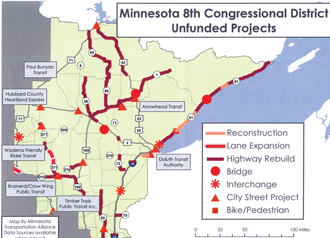February 20, 2014 at 2:37 p.m.
Alliance for all things transportation holds brainstorm session
Why is America spending billions rebuilding infrastructure in foreign nations when the transportation trust fund that pays for road and bridge projects in the U.S. is proving to be insufficient for needs here? Why do we continue to assess a gas tax in cents per gallon sold, instead of as a percentage of the cost at the pump, like all the other sales taxes?
Will Congress inadvisedly accept a short term re-authorization of an unpopular transportation funding act when the current act expires in 2014, and not resolve long term funding questions? The Highway Trust Fund outlays will exceed revenues by 2015-2016, according to the Congressional Budget Office. What about the local roadways getting beat-up by intensive interstate commercial trucking behind the hydraulic sand fracturing industry, which benefits the entire nation? These are examples of some of the dimensions of issues discussed Saturday in North Branch, at a roundtable organized by The MN Transportation Alliance. The meeting attracted policymakers, engineers, elected officials and others who came to spend part of the morning with U.S. Congressman Rick Nolan, D-8. Rep. Nolan explained that after three terms in the congress serving Minnesota over 30 years ago; he has lived in the private sector for the last couple decades, and shipping goods was a big part of his companies’ operations. He knows about things like weight restrictions and national highway system needs. He also had to balance a small business checkbook or two.
“At the end of the day, it is about priorities,” Nolan commented. He said a decline in revenues for national transportation needs is partly due to more efficient vehicles using less fuel, which is good for the environment, he adds. The federal gas tax also hasn’t been adjusted since 1993. The MN Alliance advocates that the gas tax ought to be a percentage of the pump price. Estimates are that a taxpayer who drives 12,000 miles a year would chip in about $100 under a new formula. Nolan compared that to the U.S. spending about $500 per citizen annually now rebuilding foreign nation’s infrastructure. He wants to change priorities and shift this spending into U.S. projects, he explained. And, he would also support revising the gas tax formula. Minnesota doesn’t just wait around for federal dollars to provide transportation needs. It was explained that while some states (ie: Alaska) rely on 90 percent federal money for projects-- Minnesota and its Dept. of Transportation get about 64 percent of project funding from D.C. In the Dakotas this is more like 70 percent federal support. In Wisconsin and Iowa it’s about 55 percent.
Chisago County Engineer Joe Triplett said the federal assistance is very important for local projects and that the latest authorization, the one congress is likely to simply extend short term, is very heavy on dollars for the National Highway System. For example, Triplett said there’s six bridges remaining in Chisago County that, if replaced, the system here could be in pretty good shape. He’d prefer a new federal funding act good for several years and which could help with projects like Highway 8 between Greenway in Wyoming, and Chisago City. Mark Wolcott, speaking for the Hwy 8 Task Force, put in a word for the list of items the task force wants to see done. Years ago, federal transportation funding (TEA and ISTEA) secured by then Congressman Jim Oberstar were very useful in tackling safety needs, now it’s more of a focus on capacity.
Nolan said he’s aware of how important it is to have a senior member like Oberstar was, on the House Transportation Committee and so he “fought” to get on this committee. He applies his years from his first service in congress, as well, for seniority. Rep. Nolan asked Wolcott to see to it the Task Force’s future un-met needs list gets to Nolan’s staff. Craig Rempp represented the mass transit angle. As director of the Isanti-Chisago Heartland Express Rempp said the gap in what’s available for operating costs and the costs themselves is growing. In 2009 the dual-county bus routes had $55 million in operating expenses. In 2015 operating expense is projected to be $128 million.
Yet available federal funding is expected to be half what it is now. Rempp said Heartland has requests for regular trips out of Chisago to Pine Technical College classes, and Cambridge area commuters would like to connect to Highway 65 metro routes. There’s many services that could be provided by Heartland but there’s not enough funding. On the plus side, though, Rep. Nolan noted Heartland Express kept about 60,000 individual vehicle trips off roads in 2013.
~ Chisago County Commissioner Ben Montzka made a pitch for funding for a new interchange at Stacy onto I-35.
~ Chisago County Commissioner Mike Robinson suggested congress developing a way to raise revenue from the energy industry; that could be funneled back to local roads damaged in supplying silica sand for hydraulic fracturing for fuel. ~ North Branch Mayor Ron Lindquist said a sand storage expansion, proposed near where the Tiller sand processing facility, could use another exit onto I-35 and has road hauling and access issues.
~ Washington County’s Lisa Weik also advocated for the 50 percent federal transit matches, important to improving mass transit systems and to relieve congestion.
~ Lynn Zeleny, Hwy 70 Coalition, spoke about needs along this deteriorating interstate route west, out of Grantsburg, Wisc.



Comments:
Commenting has been disabled for this item.